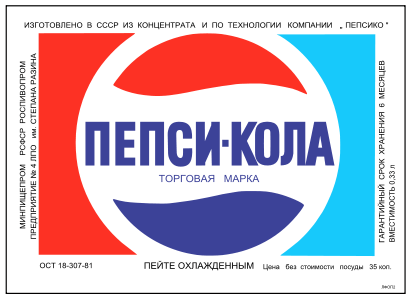The rivalry between Coke and Pepsi is caustic enough that the term “Cola Wars” is generally recognized in America. As part of that war, Pepsi actually acquired a flotilla of warships in 1989. So many in fact that Pepsi could have bee considered the sixth strongest military in the world at the time.
The story has it’s inceptions three decades earlier. In the summer of 1959, the U.S. sponsored the American National Exhibit in Moscow, designed to show Soviet people how Americans lived. Today, it’s most remembered for the so-called kitchen debate between then-Vice President Richard Nixon and then-Soviet Premier Nikita Khrushchev. But it also allowed Pepsi to open the door to the Russian market.
Pepsi had a booth at the exhibition and late Pepsi C.E.O. Donald Kendall told Nixon, “[S]omehow, I had to get a Pepsi in Khrushchev’s hand.” After the kitchen debate, Nixon steered Khrushchev to the Pepsi booth. Soon pictures of Khrushchev drinking from a Pepsi cup were transmitted around the world. By the time the exhibition closed six weeks later hundreds of thousands of Soviet people tasted more than three million cups of the drink.

Soviet Pepsi label
Within 10 days of Nixon’s 1972 reelection as president, Kendall announced that Pepsi would become the first American consumer product manufactured and sold in the Soviet Union. The 10-year deal gave Pepsi exclusive rights to the Soviet market, preventing Coca-Cola from importing its cola products into any Warsaw Pact countries. Because the Soviet ruble was inconvertible on the world market, the Soviets paid for the syrup used to make Pepsi by giving Pepsi exclusive U.S. rights to sell Stolichnaya vodka (“Stoli”) and some other Soviet-produced alcohol.
The first bottle of Pepsi came off the line of a Soviet bottling plant in 1974. It was the first of some 23 plants to open in the Soviet Union. In 1989 Pepsi sold $500 million worth of soda in the Soviet Union. In contrast, Stoli sales in the U.S. totaled about $156 million. Plainly, Stoli sales wouldn’t cover demand or allow for increased production.
So in May 1989, Pepsi reached a deal with Soviet Premier Mikhail Gorbachev: Pepsi would get 17 decommissioned, obsolete Soviet diesel attack submarines along with a decommissioned cruiser, destroyer and frigate. Pepsi also bought new Soviet oil tankers. In one fell swoop, Pepsi was one of the world’s 10 largest military powers. The submarines were in terrible disrepair and the surface warships weren’t much better. Pepsi sold the warships for scrap and leased out or sold the new oil tankers.
It wasn’t the last time Pepsi would trade cola syrup for ships. In April 1990 it reached a deal with the Soviets estimated to net $3 billion in sales of Pepsi in the Soviet Union and vodka in America. As part of the agreement, the Soviet Union would trade at least 10 tankers and freighters valued at more than $300 million.
Unfortunately for Pepsi, the Soviet Union fell in 1991, taking with it Pepsi’s exclusive deal. Uncompleted ships from the 1990 deal were stranded uncomplete and Pepsi now had to negotiate with more than a dozen different states instead of a monolith. Even worse from Pepsi’s standpoint, by 2019 Coca-Cola was the most popular non-alcoholic drink in Russia; Pepsi was third.
Ain’t singin’ for Pepsi
Ain’t singin’ for Coke
I don’t sing for nobody
Makes me look like a joke
Neil Young, Title Track, This Note’s for You







